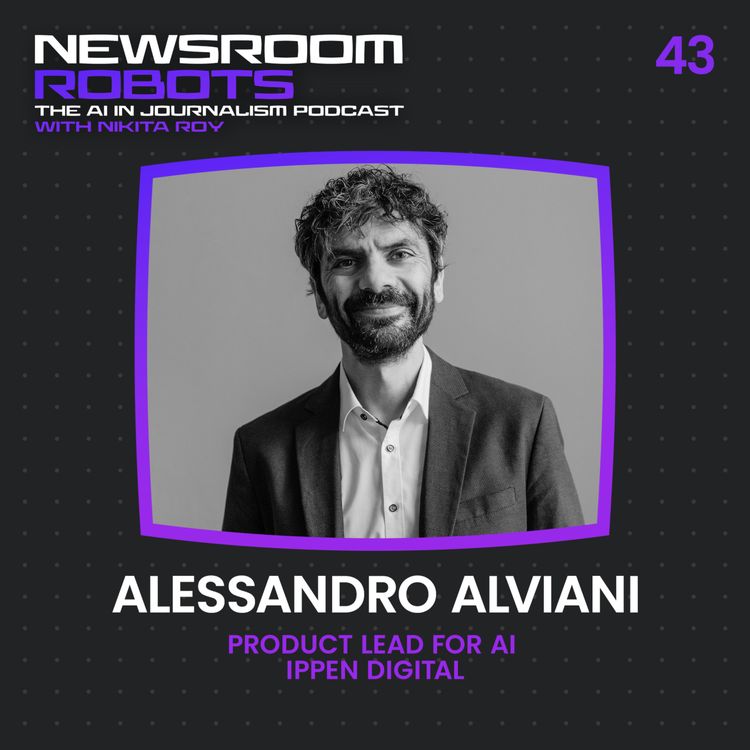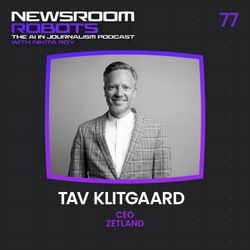Share

Newsroom Robots
Alessandro Alviani (Part One): Building AI Products with an Editor-Centric Approach
Rather than AI replacing journalists, Alessandro Alviani believes editorial teams can leverage AI to enhance and augment their work.
Formerly as the Editorial Director at the Microsoft News Hub, Alessandro experienced firsthand the consequences that replacing human editors with automated systems caused. Drawing from his experience he says that the key is to empower journalists with AI tools rather than displace them. "It's our responsibility to help editors develop a more realistic approach to AI," he says.
Now, as the Product Lead on AI at the German newsroom Ippen Digital, Alessandro has led the creation of a range of innovative AI products - from interview transcription tools to illustration generators - with transparency, responsibility, and human oversight as key principles.
What I found particularly interesting was his three-pronged strategy towards an editorial-first approach to building AI products: internships with his product team, having two editors embedded within his 10-person team, and deep-dive discovery sessions across their newsrooms to understand editorial needs.
This approach, which emphasizes collaboration and hands-on involvement, led to innovations such as an editorial assistant that was developed with input from human editors. With transparency and human oversight as guiding principles, Ippen's AI team built a self-evaluation system on top of their generative AI tools to automatically evaluate the quality of their output.
Through their internal AI training programs, Ippen Digital strives to give every employee - not just technologists - a solid understanding of how AI models function, where they fall short, and why human judgment is irreplaceable.
My biggest takeaway from Alessandro was this: by proactively shaping how AI gets built and deployed, journalists have an opportunity to set their direction. The future of news isn't human versus AI - it's human augmented by AI. And for the survival of quality journalism, getting that balance right is imperative.
In the second part of our conversation out next week, Alessandro discusses how Ippen Digital is working on fine-tuning large language models for specific newsroom tasks. He also discusses his collaboration with colleagues at The Times of London as a 2022 JournalismAI fellow, where he developed a tool and methodology for journalists to track manipulated narratives, especially those from state-run media.
More episodes
View all episodes

77. Tav Klitgaard: How Zetland turned a newsroom problem into a global AI business
38:13||Ep. 77This week on Newsroom Robots, host Nikita Roy is joined by Tav Klitgaard, the CEO of the Danish newsroom Zetland, to unpack the origin story of GoodTape — an AI transcription tool that began as an internal newsroom solution and evolved into a profitable, global product used far beyond journalism.Zetland is an audio-first newsroom in Denmark. But GoodTape wasn’t born from an AI strategy or a product roadmap. It emerged from a familiar newsroom pain point of journalists spending hours transcribing interviews, with existing tools falling short, especially in non-English languages like Danish.In this conversation, Tav breaks down how GoodTape went from an internal experiment to a standalone, subscription-based product that quickly became profitable, generated millions in revenue and was eventually divested. He also shares what building GoodTape taught Zetland about AI adoption, organizational learning, and where newsrooms should, and shouldn’t, use generative AI.This episode covers:05:50 – How a prototype using OpenAI’s Whisper sparked GoodTape08:36 – The moment Zetland realized GoodTape could be a real product12:34 – How journalism’s trust and privacy standards became a product advantage13:59 – What actually improves transcription quality beyond the model itself15:27 – How GoodTape became profitable and contributed to Zetland’s revenue16:29 – Why Zetland eventually divested GoodTape instead of scaling it internally17:36 – What building an AI product taught Zetland about newsroom AI adoption19:08 – Why Zetland uses AI for productivity, not editorial output28:14 – A real-world example of AI use that forced Zetland to rethink its own guidelines30:34 – Why principles matter more than rigid AI rules in newsrooms🎧 Listen to the full conversation with Tav Klitgaard on Apple Podcasts, Spotify, or your favorite podcast platform.
76. Markus Franz: How Germany's Ippen Digital Is Prototyping the AI-Powered Newsroom of the Future
51:44||Ep. 76How do you redesign a newsroom’s entire workflow when AI is no longer a single tool, but a collection of agents, voice interfaces, and ambient intelligence changing how journalism gets produced?This week on Newsroom Robots, host Nikita Roy is joined by Markus Franz, Chief Technology Officer at Ippen Digital, one of Germany’s largest digital media networks with more than 80 online news and media portals. This episode was recorded live at the Digital Growth Summit in Stuttgart, where Markus shared how his team is building some of the most forward-looking AI experiments in European media.Markus leads Ippen Digital’s Incubator Lab, an innovation unit focused on reimagining how publishing and AI-driven experiences will evolve. With 16 years inside the company, Markus has been central to Ippen’s digital transformation and now leads efforts around multi-agent architectures and building adaptive workflows for the newsroom.In this conversation, Markus breaks down how his lab is experimenting with multi-agent “virtual teams,” voice-first newsroom interfaces, multimodal content production and an ambient AI-powered newsroom where intelligent systems support journalists in real time. He shares what his team has learned from early prototypes, why the biggest challenges are cultural rather than technical, and how news organizations should think about guardrails, platform dependency, and the rise of self-evolving models.This episode covers: 02:22 – Why Ippen Digital built an Incubator Lab and how it’s structured as a future-focused R&D unit04:49 – What multi-agent systems look like inside a newsroom9:42 – The case for voice as the next major interface for both journalists and audiences14:41 – The shift from human-in-the-loop to human-on-the-loop workflows17:40 – Guardrails for agent systems: grounding, bounding, editorial policies19:33 – The vision for an ambient newsroom powered by AI companions and real-time intelligence27:31 – Why vendor lock-in and self-evolving LLMs pose new strategic risks30:08 – Multimodal personalization and rethinking how news is experienced34:27 – Why most AI pilots fail and what experimentation looks like in practice49:19 – Markus’s personal AI stack and how he uses these tools day-to-daySign up for the Newsroom Robots newsletter for episode summaries and insights from host Nikita Roy.
75. Olle Zacharison: How BBC News is Shaping its AI Strategy for the Next Era of Journalism
01:05:39||Ep. 75How do you bring AI into a newsroom as big and globally distributed as the BBC, an editorial network that stretches across 42 languages and more than 5,000 journalists?This week on Newsroom Robots, host Nikita Roy talks to Olle Zachrison, Head of News AI at BBC News, where he leads the BBC’s efforts to advance AI use and strengthen its journalism and audience experiences. Previously, the Head of AI at Swedish Radio, Olle has spent the past few years implementing practical newsroom AI workflows while upholding public-service values.In this conversation, Olle breaks down BBC’s four-part AI strategy, covering large-scale translation and transcription, content reformatting, investigative tools, and early experiments with synthetic audio and conversational news. He shares what’s working inside one of the world’s largest news organizations, what routinely stalls AI projects, and why the most challenging part of AI transformation isn’t the technology but the collaboration required across editorial, product, and engineering. Olle also reflects on what it means to innovate as a public broadcaster in an AI-driven ecosystem, and why archives, credibility, and direct audience relationships will determine which journalism remains indispensable in the years ahead.This episode covers:03:39 – The BBC’s four-part AI strategy: Boosting productivity, reformatting content, augmenting journalism, and innovating user experience as the core themes05:10 – Using AI for large-scale transcription, tagging, live pages, alt text, newsletter production, and translation to save time and make content more searchable.08:17 – Reformatting content across platforms and formats20:59 – Innovating user experiences with synthetic audio and conversational formats31:59 – How the BBC uses strategic themes, clear metrics, and fast pilots to decide what’s worth building and scaling46:59 – Inside the BBC’s fine-tuned LLM and Style Assist52:01 – What it means to be a public broadcaster in an AI-driven ecosystem01:02:58 – Olle’s personal AI stackSign up for the Newsroom Robots newsletter for episode summaries and insights from host Nikita Roy.
74. Vilas Dhar: Why the Future of Journalism Is Still Human
46:58||Ep. 74This week on Newsroom Robots, host Nikita Roy sits down with Vilas Dhar, President of the Patrick J. McGovern Foundation, one of the world's foremost philanthropies advancing AI for public good. Dhar leads a $1.5 billion endowment that has committed over $500 million to projects spanning climate action, public health, education, and democratic governance. He has served on the UN Secretary-General's High-Level Advisory Body on AI, is the U.S. government's nominated expert to the Global Partnership on AI, and was named a World Economic Forum Young Global Leader in 2022.Across philanthropy, policy, and technology, Dhar carries one central conviction: technology may accelerate, but the future of journalism and society must remain human-centered. Dhar introduces a three-part framework for ethical AI deployment (responsible data, clear boundaries, and transparency) and explains how to translate abstract principles into concrete newsroom decisions. He unpacks his LISA framework (Listen, Involve, Share, Assess) for audience-centered AI design, and tackles the hardest questions facing newsroom leaders: Should we buy or build AI tools? How do we balance innovation with environmental sustainability? What happens to human creativity when machines can create?But perhaps most powerfully, Dhar challenges a deeply held belief in journalism: that media organizations can remain ‘just’ media companies in an AI-driven world. There is no way to be a media organization today without also being a technology organization, he argues, and that shift requires not just new tools, but a fundamental reckoning with organizational identity and purpose. This epiosde covers:00:31 – Introducing Vilas Dhar and his human-centered AI vision: Why technology should serve dignity, equity, and democracy—not just profit02:17 – The three-part framework for ethical AI: Responsible data, clear boundaries, and transparency as actionable principles07:08 – Questions leaders must ask before deploying AI: Who's involved? Who's accountable? Who has editorial control over AI use?10:16 – The LISA framework: Listen, Involve, Share, Assess to turn AI experimentation into behind-the-scenes reporting that builds public trust13:30 – Navigating ethical dilemmas around AI-generated content13:51 – The three phases of newsroom AI adoption18:54 – Why "we're not a tech company" no longer works23:12 – Organizational reckoning in an 18-month transformation cycle25:23 – Why smaller, targeted models and collective action matter more than massive systems29:14 – Fighting misinformation with AI34:13 – What journalism is missing compared to other industries37:01 – The evolving role of human creativity and agency39:33 – The McGovern Foundation's North Star44:23 – How Vilas uses AI personallySign up for the Newsroom Robots newsletter for episode summaries and insights from host Nikita Roy.
73. Ludwig Siegele: Inside The Economist’s AI Playbook
41:17||Ep. 73How does a 182-year-old global magazine stay ahead in the age of generative AI? This week on Newsroom Robots, host Nikita Roy is joined by Ludwig Siegele, Senior Editor for AI Initiatives at The Economist. After more than 25 years reporting from San Francisco, Berlin, and London, Siegele now leads the publication’s AI strategy. He discusses how The Economist launched its AI Lab—a startup-style group within the organization with the freedom to test bold ideas and move quickly. The lab is charged with looking years ahead, preparing for a future where much of journalism’s supply chain may be automated, and ensuring The Economist maintains its identity in an AI-driven media ecosystem.From practical newsroom wins like AI-powered translation and research pipelines to more experimental projects such as TikTok video dubbing and the SCOTUS bot, Siegele explains how The Economist is testing, iterating, and learning in real time. He also reflects on what hasn’t worked, the challenges of newsroom adoption, and why the next phase of journalism may require redefining the role of the journalist itself.In this episode:00:00 – Introducing Ludwig Siegele & The Economist’s AI journey01:31 – How AI experimentation began at The Economist03:26 – Overcoming newsroom fear of ChatGPT04:53 – Building AI infrastructure and upskilling staff07:10 – The tools and vendor partnerships powering experiments08:29 – Why adoption is harder than building tools12:10 – Translation, research, and NotebookLM as newsroom game changers16:06 – How automation could reshape the journalist’s role18:41 – Launching The Economist AI Lab24:11 – Audience-facing AI experiments (TikTok dubbing, Espresso app, SCOTUS bot)26:05 – Partnering with Google NotebookLM while protecting the brand30:02 – Scraping, monetization, and the future of publisher revenue33:41 – Measuring ROI on AI initiatives37:40 – The biggest barriers to newsroom AI adoption39:14 – How Ludwig uses AI personally in art and culture40:40 – Closing reflectionsSign up for the Newsroom Robots newsletter for episode summaries and insights from host Nikita Roy.
72. Ivar Krustok: How Estonia’s Media Giant Builds AI That Actually Works
01:05:58||Ep. 72In Estonia, Delfi Meedia has built one of the strongest foundations for AI in journalism. With one of the highest digital subscription rates in the world, Delfi has moved beyond the buzz around AI to put it into everyday practice, supporting both its journalism and business.In this episode, host Nikita Roy is joined by Ivar Krustok, Chief AI & Innovation Officer at Delfi Meedia. Ivar breaks down how a small-market publisher is shipping AI that actually helps journalists: from live cross-language translation and newsroom bots to an in-house “company ChatGPT” toolkit wired into 25 years of archives and public records.Key topics include:• Delfi’s three-bucket AI strategy: everyday newsroom tools, experimental long-term projects, and company-wide literacy.• Why Delfi built its own “company ChatGPT” toolkit to search 25 years of archives.• How bots and agents are transforming dashboards into conversational tools for subscriptions, ads, and editorial performance.• Lessons from AI experiments, from court-case monitoring that surfaces hidden stories to audience-facing image generators.• The ongoing challenge of scaling AI literacy across hundreds of staff while keeping adoption practical and trust-centered.Sign up for the Newsroom Robots newsletter for episode summaries and insights from host Nikita Roy.
71. Djordje Padejski: Why AI Literacy Belongs at the Core of Journalism Education
47:40||Ep. 71As a new academic year begins, journalism schools face a defining challenge: how to prepare students for a profession being reshaped by AI.At Stanford University, Djordje Padejski is leading the way. A veteran investigative journalist and now associate director of the John S. Knight Journalism Fellowships at Stanford, he created one of the earliest AI-focused journalism courses at Arizona State University before bringing it to Stanford last year. His classroom is less lecture hall and more lab, where students test AI tools and also learn to examine them.On Newsroom Robots, Djordje shared how he structures his course and what journalism schools must do to prepare the next generation of journalists.Key topics include:Why journalism education must move beyond teaching AI as just a tool and instead frame it as a socio-technical phenomenon.How to embed AI literacy in classrooms by separating hype from reality, contextualizing the history of AI, and examining its cultural and ethical limits.Practical strategies Djordje uses to structure his Stanford course, from lab-style experimentation to peer-led discussions that uncover both opportunities and pitfalls of tools like ChatGPT, Perplexity, and NotebookLM.The importance of teaching students not just how to use AI but how to critically assess its strengths, biases, and limitations.What a future journalism curriculum or degree built around AI might look like, and how educators across disciplines can prepare the next generation of reporters.Sign up for the Newsroom Robots newsletter for episode summaries and insights from host Nikita Roy.
70. Sara Beykpour: The Next Chapter in News Aggregation
51:31||Ep. 70In this episode, host Nikita Roy is joined by Sara Beykpour, co-founder and CEO of Particle News — the AI-powered news aggregator. Launched in November 2024, Particle blends multi-perspective coverage, concise AI-generated summaries, and a bias meter that makes framing visible, giving readers both speed and trust in the same experience.Key topics include:How Particle’s “Reality Check” process works using multi-source input and verification passes to minimize hallucinations and produce more accurate summaries.Strategies Particle uses to maintain reader trust in an era when AI-generated summaries can quickly erode it.How Particle surfaces bias with a meter that shows how coverage leans left, right, or center and updates as stories develop.The role of topic-based personalization in avoiding filter bubbles while still giving readers tailored news feeds.Sign up for the Newsroom Robots newsletter for episode summaries and insights from host Nikita Roy.
69. Florent Daudens: How Open-Source AI Puts Newsrooms Back in the Driver’s Seat
01:04:24||Ep. 69What if the future of journalism isn’t locked behind the paywalls of big tech companies, but freely available to every newsroom willing to embrace it?Too often, the conversation around AI in newsrooms centers on big tech, like OpenAI’s ChatGPT or Google’s Gemini. These are powerful tools, no doubt but they come with caveats: mainly cost, limited transparency, and little to no control over where your data ends up.But there’s another world of AI rapidly evolving in parallel and it might be journalism’s best path forward: open-source AI.In this episode of Newsroom Robots, host Nikita Roy reconnects with returning guest Florent Daudens, now the Press Lead at Hugging Face, one of the leading platforms powering open source AI. Formerly a newsroom leader driving AI integration at Canada’s Radio-Canada, Florent now sits at the heart of the open source AI movement.Key topics include:Why open source AI matters for journalism and how it compares to proprietary modelsThe rise of AI agents and what they mean for editorial control and user experienceHow compressed, privacy-first models running on laptops and phones could change the gameThe environmental cost of AI and how newsrooms can make more sustainable tech choicesWhat news apps might look like in an agent-powered futureHow newsrooms can start experimenting with open source AI (no dev team required)Plus, Florent shares 20 must-know open source AI tools for journalists, explains how writing is building in the age of AI, and discusses why owning the experience, not just the content, will be key to journalism’s survivalSign up for the Newsroom Robots newsletter for episode summaries and insights from host Nikita Roy.